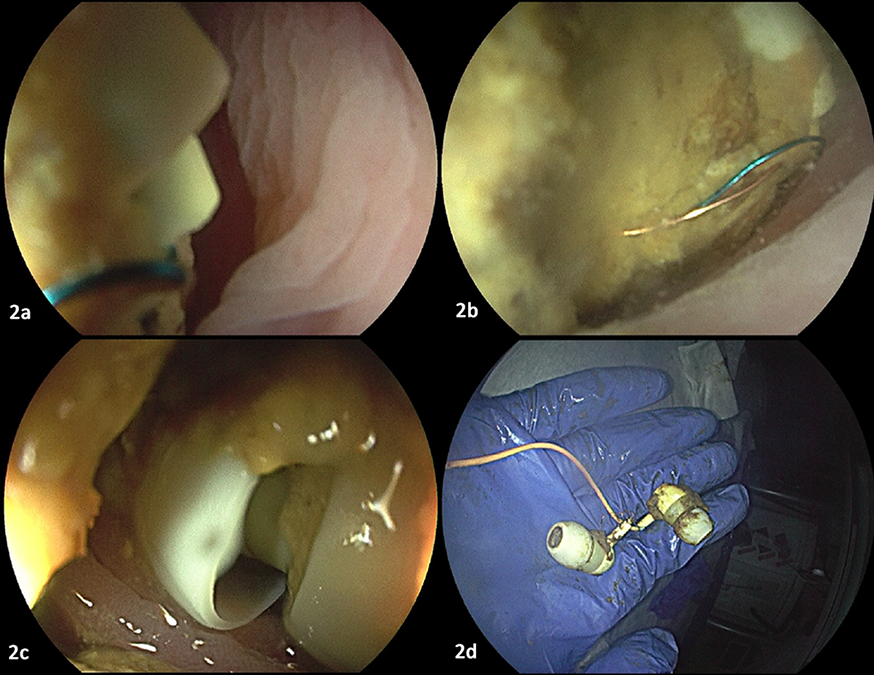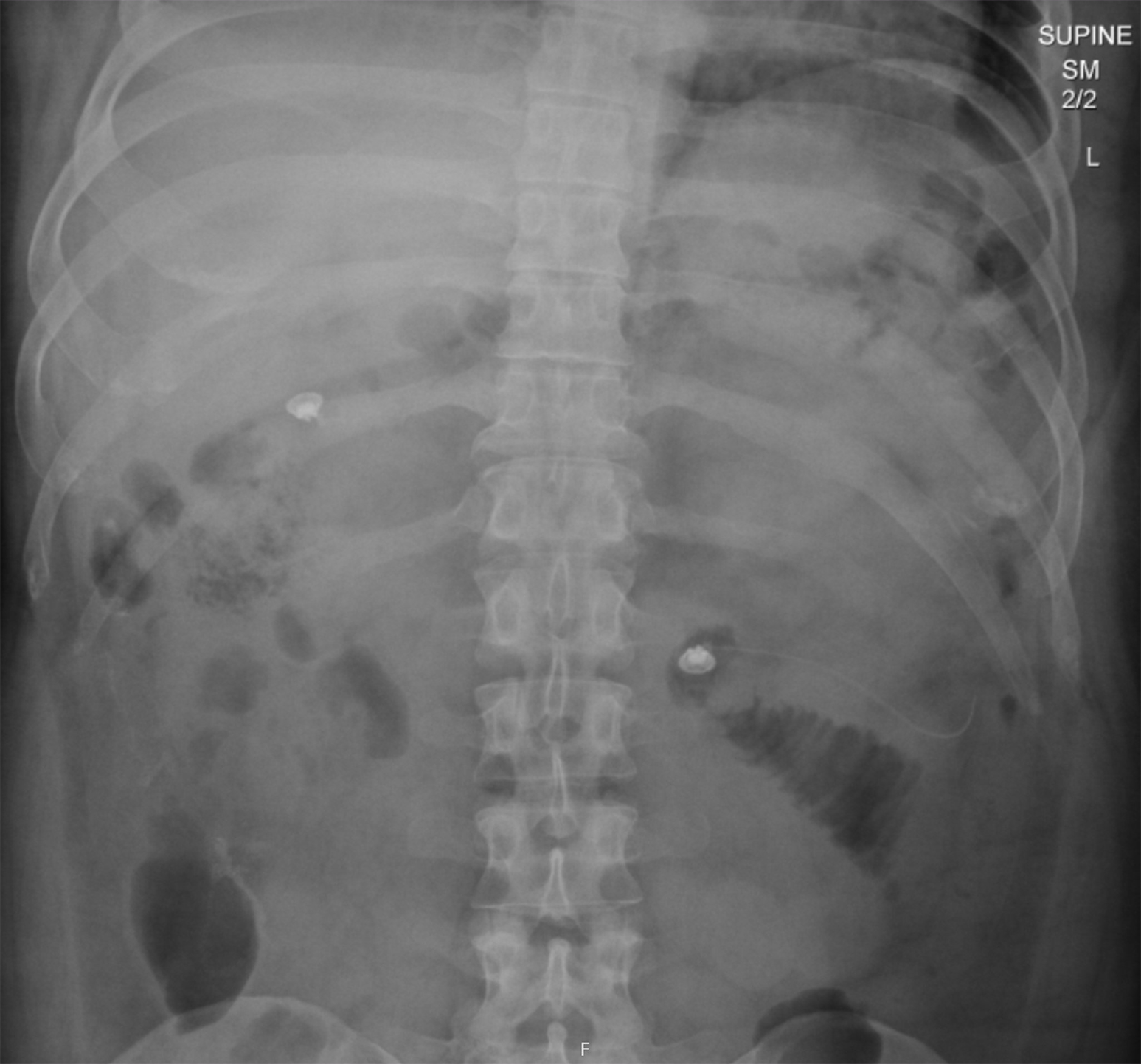Sunday Poster Session
Category: General Endoscopy
P0897 - Listen to Your Gut: A Case Report Highlighting the Risk of Caustic Injuries From Ingestion of Wearable Technologies
Sunday, October 26, 2025
3:30 PM - 7:00 PM PDT
Location: Exhibit Hall
- YK
Yuri Kwon, MD, MPH
University of California Irvine Health
Orange, CA
Presenting Author(s)
Yuri Kwon, MD, MPH1, Peter H. Nguyen, MD1, Nathan Park, MD2, Andy Lin, MD3, Shoujit Banerjee, MD3, Bryant Le, MD3, Amirali Tavangar, MD2, Jason Samarasena, MD, MBA, FACG3, Christopher Paiji, MD2
1University of California Irvine Health, Orange, CA; 2University of California Irvine Digestive Health Institute, Orange, CA; 3University of California Irvine, Orange, CA
Introduction: Lithium-ion (Li-ion) batteries are the battery of choice for wearable technologies for their compact size with powerful charge1. Due to its popularity in technology, caustic injuries secondary to lithium ingestion continue to be a major problem with 855 lithium battery ingestions reported to the National Poison Data System in 20232-3. This case report discusses the importance of considering the internal components of wearable technologies when managing foreign body ingestions.
Case Description/
Methods: A 28 year-old male with history of autism spectrum disorder, recurrent suicidal ideations, and schizoaffective disorder with command auditory hallucinations presented overnight after swallowing reported Bluetooth earbuds. He previously underwent ileostomy, partial colectomy, and reversal anastomosis after ingesting batteries. On presentation, he was endorsing epigastric and left upper quadrant pain. Initial abdominal X-ray showed mobile radio-opaque foreign bodies in the gastric lumen. Repeat abdominal X-ray 5 hours later showed the foreign bodies with a possible wire connection in mid-abdomen. Urgent enteroscopy the next day did not show any foreign bodies in the stomach, duodenum or proximal jejunum. Patient endorsed worsening umbilical abdominal pain. CT Abdomen and Pelvis the same evening showed 2 metallic ovoid structures at the transverse and proximal descending colon respectively. Flexible sigmoidoscopy was performed the following day and found one earbud covered in stool with exposed wires, another earbud covered in stool with approximately 5 cm wire attached, and wire fragments which were all retrieved.
Discussion: Caustic injuries from ingestion of lithium batteries are well-documented in literature; however, wearable technologies are becoming increasingly popular. This includes smart rings, earrings, watches, glasses, and Bluetooth earbuds which are small enough to ingest and include lithium batteries. Prompt recognition of wearable technologies when managing foreign body ingestions is important to prevent delays in appropriate interventions and avoid potential complications.
References:
1. Palmieri TL, Yelon J, Shapiro D, Duncan T, Kuhls D. Journal of Trauma and Acute Care Surgery. 2018 Aug 1; 85(2): 406–409.
2. Hall AH, et al. Crit Rev Toxicol. 2019 Sep 14; 49(8): 637–669.
3. Gummin DD, Mowry JB, Beuhler MC, Spyker DA, Rivers LJ, Feldman R, Brown K, Pham NP, Bronstein AC, DesLauriers C. Clinical Toxicology. 2024 Dec 1; 62(12): 793–1027.

Figure: Figure 1. Abdominal X-ray demonstrating two earbuds with a visualized wire component.

Figure: Figure 2. One earbud with exposed wires within the descending colon (2a, 2b), second earbud within the descending colon (2c), earbuds post retrieval (2d).
Disclosures:
Yuri Kwon indicated no relevant financial relationships.
Peter Nguyen indicated no relevant financial relationships.
Nathan Park indicated no relevant financial relationships.
Andy Lin indicated no relevant financial relationships.
Shoujit Banerjee indicated no relevant financial relationships.
Bryant Le indicated no relevant financial relationships.
Amirali Tavangar indicated no relevant financial relationships.
Jason Samarasena: Applied Medical – Consultant. Boston Scientific – Consultant. Cook Medical – Consultant. Neptune Medical – Consultant. Olympus – Consultant.
Christopher Paiji indicated no relevant financial relationships.
Yuri Kwon, MD, MPH1, Peter H. Nguyen, MD1, Nathan Park, MD2, Andy Lin, MD3, Shoujit Banerjee, MD3, Bryant Le, MD3, Amirali Tavangar, MD2, Jason Samarasena, MD, MBA, FACG3, Christopher Paiji, MD2. P0897 - Listen to Your Gut: A Case Report Highlighting the Risk of Caustic Injuries From Ingestion of Wearable Technologies, ACG 2025 Annual Scientific Meeting Abstracts. Phoenix, AZ: American College of Gastroenterology.
1University of California Irvine Health, Orange, CA; 2University of California Irvine Digestive Health Institute, Orange, CA; 3University of California Irvine, Orange, CA
Introduction: Lithium-ion (Li-ion) batteries are the battery of choice for wearable technologies for their compact size with powerful charge1. Due to its popularity in technology, caustic injuries secondary to lithium ingestion continue to be a major problem with 855 lithium battery ingestions reported to the National Poison Data System in 20232-3. This case report discusses the importance of considering the internal components of wearable technologies when managing foreign body ingestions.
Case Description/
Methods: A 28 year-old male with history of autism spectrum disorder, recurrent suicidal ideations, and schizoaffective disorder with command auditory hallucinations presented overnight after swallowing reported Bluetooth earbuds. He previously underwent ileostomy, partial colectomy, and reversal anastomosis after ingesting batteries. On presentation, he was endorsing epigastric and left upper quadrant pain. Initial abdominal X-ray showed mobile radio-opaque foreign bodies in the gastric lumen. Repeat abdominal X-ray 5 hours later showed the foreign bodies with a possible wire connection in mid-abdomen. Urgent enteroscopy the next day did not show any foreign bodies in the stomach, duodenum or proximal jejunum. Patient endorsed worsening umbilical abdominal pain. CT Abdomen and Pelvis the same evening showed 2 metallic ovoid structures at the transverse and proximal descending colon respectively. Flexible sigmoidoscopy was performed the following day and found one earbud covered in stool with exposed wires, another earbud covered in stool with approximately 5 cm wire attached, and wire fragments which were all retrieved.
Discussion: Caustic injuries from ingestion of lithium batteries are well-documented in literature; however, wearable technologies are becoming increasingly popular. This includes smart rings, earrings, watches, glasses, and Bluetooth earbuds which are small enough to ingest and include lithium batteries. Prompt recognition of wearable technologies when managing foreign body ingestions is important to prevent delays in appropriate interventions and avoid potential complications.
References:
1. Palmieri TL, Yelon J, Shapiro D, Duncan T, Kuhls D. Journal of Trauma and Acute Care Surgery. 2018 Aug 1; 85(2): 406–409.
2. Hall AH, et al. Crit Rev Toxicol. 2019 Sep 14; 49(8): 637–669.
3. Gummin DD, Mowry JB, Beuhler MC, Spyker DA, Rivers LJ, Feldman R, Brown K, Pham NP, Bronstein AC, DesLauriers C. Clinical Toxicology. 2024 Dec 1; 62(12): 793–1027.

Figure: Figure 1. Abdominal X-ray demonstrating two earbuds with a visualized wire component.

Figure: Figure 2. One earbud with exposed wires within the descending colon (2a, 2b), second earbud within the descending colon (2c), earbuds post retrieval (2d).
Disclosures:
Yuri Kwon indicated no relevant financial relationships.
Peter Nguyen indicated no relevant financial relationships.
Nathan Park indicated no relevant financial relationships.
Andy Lin indicated no relevant financial relationships.
Shoujit Banerjee indicated no relevant financial relationships.
Bryant Le indicated no relevant financial relationships.
Amirali Tavangar indicated no relevant financial relationships.
Jason Samarasena: Applied Medical – Consultant. Boston Scientific – Consultant. Cook Medical – Consultant. Neptune Medical – Consultant. Olympus – Consultant.
Christopher Paiji indicated no relevant financial relationships.
Yuri Kwon, MD, MPH1, Peter H. Nguyen, MD1, Nathan Park, MD2, Andy Lin, MD3, Shoujit Banerjee, MD3, Bryant Le, MD3, Amirali Tavangar, MD2, Jason Samarasena, MD, MBA, FACG3, Christopher Paiji, MD2. P0897 - Listen to Your Gut: A Case Report Highlighting the Risk of Caustic Injuries From Ingestion of Wearable Technologies, ACG 2025 Annual Scientific Meeting Abstracts. Phoenix, AZ: American College of Gastroenterology.

